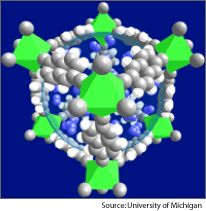Carbon-Based Materials, High-Surface-Area Sorbents, and New Materials and Concepts
This category of materials-based storage technologies includes a range of carbon-based materials such as carbon nanotubes, aerogels, nanofibers (including metal-doped hybrids), as well as metal-organic frameworks, conducting polymers, and clathrates. If structures can be tailored at the nano-scale, hydrogen storage could be enhanced.
Carbon-Based Materials

Single-walled carbon nanotubes are being studied as hydrogen storage materials because of published hydrogen gravimetric capacities in the range of 3–10 wt.% at room temperature. However, there has been controversy due to difficulty in reproducing these results. Hence, the current R&D focus for carbon nanotubes has been on establishing reproducibility. Recent results at NREL show that, while no hydrogen storage was observed in pure single-walled carbon nanotubes, roughly 3 wt.% was measured in metal-doped nanotubes at room temperature, as is shown in the graph below.
The room temperature gravimetric capacity measured in carbon nanotubes is below the 2010 system target of 6.0 wt.%, and further improvements must be made. In addition, low-cost, high-volume manufacture processes must be developed for single-walled carbon nanotubes in order for them to be economically viable in vehicular applications. The DOE Hydrogen Program has a go/no-go decision point planned on carbon nanotubes at the end of FY2006 based on a reproducibly demonstrated material hydrogen storage gravimetric capacity of 6 wt.% at room temperature.

Carbon Nanotube Sorption Science External Peer Review of NREL Activities, January 19–23, 2004
Learn about DOE's Carbon-based materials, high-surface-area sorbents and new materials and concepts R&D.
High-Surface-Area Sorbents and New Materials and Concepts
There is a pressing need for the discovery and development of new reversible materials. One new area that may be promising is that of high-surface-area hydrogen sorbents based on microporous metal-organic frameworks (MOFs). Such materials are synthetic, crystalline, and microporous and are composed of metal/oxide groups linked together by organic struts. Hydrogen storage capacity at 78K (-195°C) has been reported as high as 4 wt.% via an adsorptive mechanism with a room temperature capacity of approximately 1 wt.%. However, due to the highly porous nature of these materials, volumetric capacity may still be a significant issue.
Another class of materials for hydrogen storage may be clathrates, which are primarily hydrogen-bonded H2O frameworks. Initial studies have indicated that significant amounts of hydrogen molecules can be incorporated into the sII clathrate. Such materials may be particularly viable for off-board storage of hydrogen without the need for high pressure or liquid hydrogen tanks.
Other examples of new materials and concepts are conducting polymers. New processes such as sonochemistry may also be applicable to help create unique, nano-structures with enhanced properties for hydrogen storage.
 |
Learn about DOE's Carbon-based materials, high-surface-area sorbents and new materials & concepts R&D.
